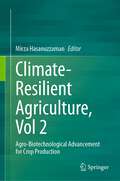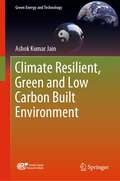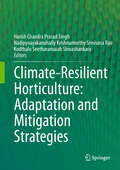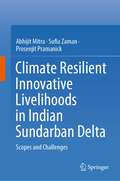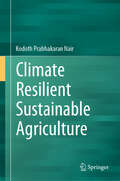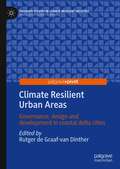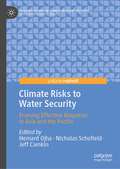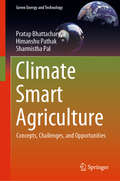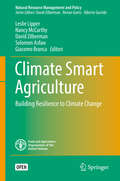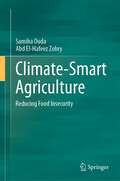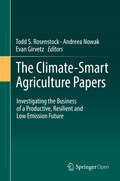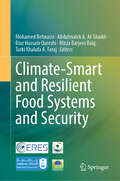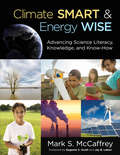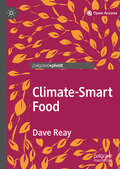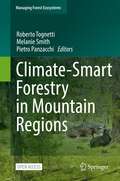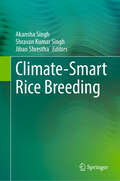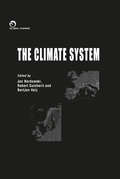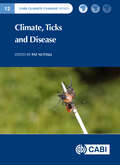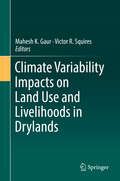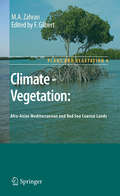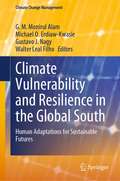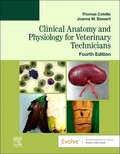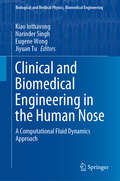- Table View
- List View
Climate-Resilient Agriculture, Vol 2: Agro-Biotechnological Advancement for Crop Production
by Mirza HasanuzzamanUnder ongoing climate change, natural and cultivated habitats of major food crops are being continuously disturbed. Such condition accelerates to impose stress effects like abiotic and biotic stressors. Drought, salinity, flood, cold, heat, heavy metals, metalloids, oxidants, irradiation etc. are important abiotic stresses; and diseases and infections caused by plant pathogens viz. fungal agents, bacteria and viruses are major biotic stresses. As a result, these harsh environments affect crop productivity and its biology in multiple complex paradigms. As stresses become the limiting factors for agricultural productivity and exert detrimental role on growth and yield of the crops, scientists and researchers are challenged to maintain global food security for a rising world population.This two-volume work highlights the fast-moving agricultural research on crop improvement through the stress mitigation strategies, with specific focuses on crop biology and their response to climatic instabilities. Together with "Climate Resilient Agriculture, Vol 1: Crop Responses and Agroecological Perspectives", it covers a wide range of topics under environmental challenges, agronomy and agriculture processes, and biotechnological approaches, uniquely suitable for scientists, researchers and students working in the fields of agriculture, plant science, environmental biology and biotechnology.
Climate Resilient, Green and Low Carbon Built Environment (Green Energy and Technology)
by Ashok Kumar JainThis book constitutes state-of-the-art research covering a wide range of topics including climate change and carbon emissions, air quality and pollution control, urbanism, land and circular economy, sustainable transport, energy, water, biodiversity and greenery, environmental services, housing, and construction with respect to the built environment. The concepts of sustainability in built environment conclude with reimagining the city. The content includes pedagogical features such as examples, simple flowing language and over 100 figures. The book aims to motivate architects, engineers, consultants, builders, and planners to respond to the challenges of sustainability in the built environment.
Climate-Resilient Horticulture: Adaptation And Mitigation Strategies
by Nadipynayakanahally Krishnamurthy Rao Kodthalu Seetharamaiah Shivashankar Harish Chandra SinghClimate change, a global phenomenon, has attracted scientists to contribute in anticipatory research to mitigate adverse impacts, which are more important for horticulture, considering that the scenario is in the midst of revolution, reaching the production level of 250 million tonnes in India. Impacts of climate variability have, invariably, profound influence on production and quality. An understanding of the impacts and relevant adaptation strategies are of foremost importance to sustain the productivity and profitability of horticulture crops in the climate change scenario, which necessitates synthesis of current knowledge to develop strategies for adaptation and mitigation to achieve climate-resilient horticulture. The book Climate-resilient horticulture: adaptation and mitigation strategies addresses the effects of climate change on different horticultural crops and focuses on the adaptation strategies based on the scientific knowledge generated by the experts in different agro-climatic regions in India. Issues have been covered in various chapters to make this book a treasure of knowledge in horticulture vis-a-vis climate change. Some of the crops included in the book are apple, grapes, cashew, banana, litchi, mango, coconut, oil palm, potato, tomato, cucurbits and flowers. In addition to strategies to be adapted in these crops, various other important aspects like carbon sequestration, pests and diseases, and urban landscaping are also covered in the book. Information on climatic risks and adaptation options for resilience in horticultural crops and future strategies and information on pest and disease dynamics on horticultural crops in relation to climate change and available mitigation strategies have also been documented. The book is edited by Dr H P Singh, a visionary leader, and his colleagues, which will be highly valuable to research workers, students, policy planners and farmers to understand and checkmate the adverse effect of climate change, so as to convert weakness into opportunity.
Climate Resilient Innovative Livelihoods in Indian Sundarban Delta: Scopes and Challenges
by Abhijit Mitra Sufia Zaman Prosenjit PramanickThis book covers several innovative alternative livelihoods based on mangrove floral resources with their respective SWOT analysis. True mangrove flora and their associates in Indian Sundarbans are noted for their wide spectrum of ecosystem services in which livelihoods of the region are one of the most important components. Many alternative mangrove-centric livelihoods are in the pipeline of startup. However, due to difficulty in marketing and lack of clarity over ownership of natural resources, the values of the mangrove-based products have not been fully realized. Natural resources of several categories in Indian Sundarbans like oysters, seaweeds, medicinal mangrove flora, vitamin-rich mangrove fruits, etc. are still lying untapped. These untapped resources have been spun with the livelihood sectors of the Sundarban people backed up with sound business models to make the venture sustainable. The carbon foot prints associated with each of these livelihoods have been studied in details and steps have been suggested for net zero carbon livelihood programmes along with their sustainability. The book provides the readers about several mangrove-based cutting-edge researches and technologies in the domain of climate resilient livelihood, which if implemented can lead to food and economic security of the region.
Climate Resilient Sustainable Agriculture
by Kodoth Prabhakaran NairThe principal focus of this book will be how to make agriculture/food production climate resilient in the ecologically sensitive zones. The Western Ghats, in the state of Kerala, India, in which Wayanad district falls, has 75% of its area classified as ecologically sensitive zones and there are three types of such zones: (1)Highly ecologically sensitive zones (2) Middle sensitivity zones and (3) Low sensitivity zones. Most of the construction has taken place in the first two categories, and, indiscriminate and intense quarrying has also taken place in these two zones. As aerosol load increases in the atmosphere, dust particles from rock quarries increases which leads to higher ambient temperature, leading to ocean warming in the Arabian ocean, finally, resulting in excessive cloud formation and consequent torrential rainfall. This has led to huge landslides, where more than 500 human lives were lost in addition to huge property loss making it a global disaster of immense proportions. The book highlights the crucial question how agriculture in these sensitive areas can be made climate resilient.
Climate Resilient Urban Areas: Governance, design and development in coastal delta cities (Palgrave Studies in Climate Resilient Societies)
by Rutger de Graaf-van DintherThis book describes the urgent challenge faced by cities worldwide to become resilient to climate change impacts. This challenge goes further than the ability to resist the impacts of extreme weather conditions. Coping with climate impacts and the ability to recover from them are equally important, as well as the capacity to adapt to the effects of climate change and the ability to transform the entire urban system. The book explores how the resilience journey for coastal cities in particular encompasses using scientific knowledge but also the knowledge of citizens and practitioners. Measures and strategies on different scales are needed, from national scale all the way down to neighbourhood, street level and building level. Representing the holistic nature of climate resilience, this collection contains unique insights from leading scientists and practitioners in areas of expertise such as engineering, social sciences and urban design. It will be a valuable resource for scholars, students, practitioners and policy makers interested in the development of resilient and sustainable urban environments.
Climate Risk Management in Agriculture: Monthly and Seasonal Forecast Application
by U. C. Mohanty Palash Sinha M. M. Nageswara Rao Dillip Kumar Swain K. K. SinghSustainable agricultural production is vital for food security and agricultural productivity. It is greatly influenced by weather and climate conditions. This book focuses on understanding weather and climate systems and crop yield productions, including integrated weather-crop prediction systems for climate risk management in agriculture. It examines the impact of climate change and its variability on different crops, and possible ways to minimize the loss for farmers. This book also describes different weather and climate hazards, including the fundamentals of weather/climate prediction systems and numerical weather prediction (NWP) models. It presents the need for seamless weather/climate predictions and their impact on agriculture. The status and availability of different monthly and seasonal scale forecasts worldwide is explored and how the forecasting models or products can be evaluated using statistical methods. The book concisely elucidates systematic model bias removal techniques and a reliable approach based on multi-statistics in producing a single forecast from the multi-model grand ensemble. Since crop models need daily weather sequence, several standard disaggregation methods for generating daily weather sequences from monthly/seasonal products are presented. This book describes several aspects that are needed for agricultural practices and crop modelling. It encapsulates different components of crop models and their application, preparation methods of Crop Weather Calendar, application of disaggregated weather sequence in crop models, and generation of Climate Risk Matrices (CRM). A detailed methodology is presented for hands-on practice, including downloading and processing data, model evaluation and bias corrections, generating a single forecast, disaggregation, and preparing CRM based on crop model products. This book contains a total 11 chapters and appeals to students, researchers, scientists, and operational agencies.
Climate Risks to Water Security: Framing Effective Response in Asia and the Pacific (Palgrave Studies in Climate Resilient Societies)
by Hemant Ojha Nicholas Schofield Jeff CamkinIn Asia and the Pacific, climate change is now a well-recognised risk to water security but responses to this risk are either under reported, or continue to be guided by the incremental or business as usual approaches. Water policy still tends to remain too narrow and fragmented, compared to the multi-sectoral and cross-scalar nature of risks to water security. What’s more, current water security debates tend to be framed in discipline specific or academic ways, failing to understand decision making and problem-solving contexts within which policy actors and partitioners have to operate on a daily basis. Much of the efforts to date has focussed on assessing and predicting the risks in the context of increasing levels of uncertainty. There is still limited analysis of emerging practices of risks assessment and mitigation in different contexts in Asia and the Pacific.Going beyond the national scales and focussing on several socio-ecological zones, this book captures stories written by engaged scholars on recent attempts to develop cross-sectoral and cross-scaler solutions to assess and mitigate risks to water security across Asia and the Pacific. Identifying lessons from successes and failures, it highlights management and strategic lessons that water and climate leaders of Asia and the Pacific need to consider. This book showcases reflective and analytical thought pieces written by key actors in the climate and water spaces. Several critical socio-ecological zones are covered – from Pakistan in the west to pacific islands in the east. The chapters clearly identify strategies for improvement based on the analysis of emerging responses to climate risks to water security and gaps in current practices. The book will include an editorial introduction and a final synthesis chapter to ensure clear articulation of common themes and to highlight the overall messages of the book.
Climate Smart Agriculture: Concepts, Challenges, and Opportunities (Green Energy and Technology)
by Pratap Bhattacharyya Himanshu Pathak Sharmistha PalThe books deals with the critical issues of climate change and its impact on agriculture and proposes climate smart agriculture as the probable solution to this issue. It discusses the impact of climate change and greenhouse gases emission on agriculture. It covers the strategies and management options of climate smart agriculture by including crop, water, soil, and energy management with examples and case studies. The subject matter has been presented in a very lucid language, containing real-time case studies, questions and few solved problems in specific chapters. The text is further enriched with simple line diagram and figures, chart, flow charts and tables. The book is primarily intended for researchers and professionals in the research areas of environmental science, agriculture, soil science, etc.
Climate Smart Agriculture: Building Resilience to Climate Change (Natural Resource Management and Policy #52)
by David Zilberman Leslie Lipper Nancy Mccarthy Solomon Asfaw Giacomo BrancaThis book is open access under a CC BY-NC-SA 3. 0 IGO license. The book uses an economic lens to identify the main features of climate-smart agriculture (CSA), its likely impact, and the challenges associated with its implementation. Drawing upon theory and concepts from agricultural development, institutional, and resource economics, this book expands and formalizes the conceptual foundations of CSA. Focusing on the adaptation/resilience dimension of CSA, the text embraces a mixture of conceptual analyses, including theory, empirical and policy analysis, and case studies, to look at adaptation and resilience through three possible avenues: ex-ante reduction of vulnerability, increasing adaptive capacity, and ex-post risk coping. The book is divided into three sections. The first section provides conceptual framing, giving an overview of the CSA concept and grounding it in core economic principles. The second section is devoted to a set of case studies illustrating the economic basis of CSA in terms of reducing vulnerability, increasing adaptive capacity and ex-post risk coping. The final section addresses policy issues related to climate change. Providing information on this new and important field in an approachable way, this book helps make sense of CSA and fills intellectual and policy gaps by defining the concept and placing it within an economic decision-making framework. This book will be of interest to agricultural, environmental, and natural resource economists, development economists, and scholars of development studies, climate change, and agriculture. It will also appeal to policy-makers, development practitioners, and members of governmental and non-governmental organizations interested in agriculture, food security and climate change.
Climate-Smart Agriculture: Reducing Food Insecurity
by Abd El-Hafeez Zohry Samiha OudaThis book tackles the main feature of water-smart, soil-smart and crop-smart practices and their integration to sustainably enhance food production. The book includes some insights on the implications of using climate-smart practices in irrigated and rain-fed agriculture, and suggests approaches to eradicate the negative effects of water scarcity, climate variability and climate change. The book reviews the most important crops resilient to climate variability and their resistance to other biotic and abiotic stresses, and contains the existing practices in Egypt that achieved the three pillars of climate-smart agriculture
The Climate-Smart Agriculture Papers: Investigating the Business of a Productive, Resilient and Low Emission Future
by Todd S. Rosenstock Andreea Nowak Evan GirvetzThis book is open access under a CC BY 4.0 license.This volume shares new data relating to Climate-Smart Agriculture (CSA), with emphasis on experiences in Eastern and Southern Africa. The book is a collection of research by authors from over 30 institutions, spanning the public and private sectors, with specific knowledge on agricultural development in the region discussed. The material is assembled to answer key questions on the following five topic areas: (1) Climate impacts: What are the most significant current and near future climate risks undermining smallholder livelihoods? (2) Varieties: How can climate-smart varieties be delivered quickly and cost-effectively to smallholders? (3) Farm management: What are key lessons on the contributions from soil and water management to climate risk reduction and how should interventions be prioritized? (4) Value chains: How can climate risks to supply and value chains be reduced? and (5) Scaling up: How can most promising climate risks reduction strategies be quickly scaled up and what are critical success factors? Readers who will be interested in this book include students, policy makers, and researchers studying climate change impacts on agriculture and agricultural sustainability.
Climate-Smart and Resilient Food Systems and Security
by Mohamed Behnassi Abdulmalek A. Al-Shaikh Riaz Hussain Qureshi Mirza Barjees Baig Turki Khalufa A. FarajThis contributed book, as a part of a series of CERES publications, contributes to the scientific debate about the interlinkages between climate change, environment, and food systems. It highlights the opportunities to accelerate the transformation of such systems within the perspective of sustainable, inclusive, and climate-smart practices. Most chapters are based on empirical research particularly done in vulnerable and resource-constrained countries from the Global South (such as India, Kenya, Pakistan, South Asia, Sri Lanka, and Vietnam) and provide policy-oriented inputs and recommendations to guide change processes at multiple scales. This project has implications for research, innovation, and policy design.
Climate Smart & Energy Wise: Advancing Science Literacy, Knowledge, and Know-How
by Mr Mark S. McCaffreyToday’s answers to our most urgent climate issues The twenty-first century ushered in a set of unmistakably urgent global challenges that are too important to be an afterthought in today’s classrooms. Climate Smart & Energy Wise offers a virtual blueprint to climate and energy education, packed with resources and strategies, including: A high-level overview of where climate and energy topics fit (or don't fit) into your current curriculum with connections to the NGSS Proven methods to teach climate change and related topics in a grade-appropriate way Sample learning activities and high-quality online resources
Climate Smart & Energy Wise: Advancing Science Literacy, Knowledge, and Know-How
by Mr Mark S. McCaffreyToday’s answers to our most urgent climate issues The twenty-first century ushered in a set of unmistakably urgent global challenges that are too important to be an afterthought in today’s classrooms. Climate Smart & Energy Wise offers a virtual blueprint to climate and energy education, packed with resources and strategies, including: A high-level overview of where climate and energy topics fit (or don't fit) into your current curriculum with connections to the NGSS Proven methods to teach climate change and related topics in a grade-appropriate way Sample learning activities and high-quality online resources
Climate-Smart Food
by Dave ReayThis open access book asks just how climate-smart our food really is. It follows an average day's worth of food and drink to see where it comes from, how far it travels, and the carbon price we all pay for it. From our breakfast tea and toast, through breaktime chocolate bar, to take-away supper, Dave Reay explores the weather extremes the world’s farmers are already dealing with, and what new threats climate change will bring. Readers will encounter heat waves and hurricanes, wildfires and deadly toxins, as well as some truly climate-smart solutions. In every case there are responses that could cut emissions while boosting resilience and livelihoods. Ultimately we are all in this together, our decisions on what food we buy and how we consume it send life-changing ripples right through the global web that is our food supply. As we face a future of 10 billion mouths to feed in a rapidly changing climate, it’s time to get to know our farmers and herders, our vintners and fisherfolk, a whole lot better.
Climate-Smart Forestry in Mountain Regions (Managing Forest Ecosystems #40)
by Roberto Tognetti Melanie Smith Pietro PanzacchiThis open access book offers a cross-sectoral reference for both managers and scientists interested in climate-smart forestry, focusing on mountain regions. It provides a comprehensive analysis on forest issues, facilitating the implementation of climate objectives. This book includes structured summaries of each chapter.Funded by the EU’s Horizon 2020 programme, CLIMO has brought together scientists and experts in continental and regional focus assessments through a cross-sectoral approach, facilitating the implementation of climate objectives. CLIMO has provided scientific analysis on issues including criteria and indicators, growth dynamics, management prescriptions, long-term perspectives, monitoring technologies, economic impacts, and governance tools.
Climate-Smart Rice Breeding
by Akansha Singh Shravan Kumar Singh Jiban ShresthaThis book covers all aspects of smart-breeding technologies in creating novel crop architecture to meet future rice demand. Several advanced crop breeding technologies like, marker-assisted backcross breeding, marker-assisted recurrent selection, genomic assisted breeding, haplotype breeding and genome editing technologies have been introduced and employed for rice productivity improvement. Use of artificial intelligence and machine learning in crop phenotype prediction is paving the way for climate-smart breeding. Chapters in this volume cover all these relevant topics. The global rice demand is estimated to rise to 555 and 827.86 million tons in 2035 for milled rice and paddy, respectively. Enhancing high-nutrition rice production under the pressure of global climate change conditions is a hard task for breeders. Changing climatic scenarios and extreme weather conditions have increased the incidence of various biotic and abiotic stresses. Also, every degree rise in global mean temperature causes 3.2 % reduction in rice yield globally. This creates an urgent need for developing high-yielding rice varieties to tackle the aggravated issue of food security. This book is meant for scientists, professionals, researchers, and students working on enhancing rice production through advanced plant-breeding technologies.
The Climate System
by JAN BERDOWSKI; ROBERT GUICHERIT; BERTJAN HEIJThese results from the National Research Programme on Climate Change of the Netherlands offer a synthesis of present knowledge in the fields of: source and sinks of greenhouse gases and aerosols; land-atmosphere interactions; the global energy balance; and radiative forcing and climate variability.
Climate, Ticks and Disease (CABI Climate Change Series #18)
by Saeed Alasmari Neil Alexander Abdelghafar Alkishe Reiko Arai Armanda Bastos Gervasio Henrique Bechara John Beier Giovanni Benelli Joshua Benoit Dennis Bente Richard Bishop Adrien Blisnick René Bødker Fernando Boinas Sarah Bonnet Nathalie Boulanger Alejandro Cabezas-Cruz Alexandre Rodrigues Caetano Cyril Caminade Jirí Cerny´ Roxanne Albertha Charles Ali Reza Chavshin Rosalind Cornforth Neil Coughlan Peter Cox Lauren Culler Milan Daniel Vlasta Danielova Mona Dehhaghi Maria Diuk-Wasser James P Duffy Olivier Duron Lars Eisen Rebecca Eisen Jana Elsterová Koray Ergünay Agustín Estrada-Peña Li-Qun Fang Natalia Fernández-Ruiz Erol Fikrig Serhii Filatov Durland Fish Janet Foley José De Fuente Roman Ganta Aysen Gargili Keles Robin Beat Gasser Abdul Ghafar Naftaly Githaka Lucy Gilbert Maryna Golovchenko Yuval Gottlieb Ernest Gould Jeremy Gray Libor Grubhoffer Gilles J. Guillemin Kayleigh M. Hansford Charles Hart John E. Healy Deborah Hemming Stephen Higgs Andrew Hoodless Yan-Jang S. Huang Bernard Hudson Chris Huntingford Peter Irwin Abdul Jabbar Nicholas Johnson Esther Kanduma Sirri Kar Maria Kazimirova Neil Kaye Thomas C. Kelly Lene Jung Kjaer Agatha Onyemowo Kolo Eduard Korenberg Nina Król Chi-Chien Kuo Timothy J. Kurtti Xavier De Lamballerie Patrick A. Leighton Hao Li L. Robbin Lindsay Wei Liu Geoffrey E. Lynn Ilya Maclean Ben J. Mans Maristela Martins de Camargo Karen D. McCoy Jolyon M. Medlock Ulrike G. Munderloh Atle Mysterud Sukanya Narasimhan Anna Obiegala Dasiel Obregón Alvarez Dr Nick H. Ogden Mari H. Ogihara Stefan Vilges Oliveira Charlotte Oskam Domenico Otranto Kennan J. Oyen Neha Pandey Hamed Kazemi Panahi A. Townsend Peterson John H. Pettersson Martin Pfeffer L. Paul Phipps Heather J. Plumpton Tatjana Pustahija Ram Raghavan Ryan O.M Rego Annapaola Rizzoli Isobel Ronai Franz Rubel Natalie Rudenko Benjamin Ruiwen Rufus Sage Abdallah M. Samy Gustavo Seron Sanches Isabel Kinney Santos Marcello Otake Sato Megumi Sato Richard Schloeffel Seyyed Javad Seyyed-Zadeh Ladislav Šimo Sunit Kumar Singh Daniel E. Sonenshine Morgan Sparey Frederic Stachurski Snorre Stuen Matias Pablo Szabó DeMar Taylor Mike Teglas Sam R. III Saravanan Thangamani Georgia Titcomb Attila J. Trájer Michael Turell Rika Umemiya-Shirafuji Dana L. Vanlandingham Laurence Vial Margarita Villar Richard Wall André B. Wilke G. R. Wint Jianhong Wu Zbigniew Zajac Xue ZhangThis book brings together expert opinions from scientists to consider the evidence for climate change and its impacts on ticks and tick-borne infections. It considers what is meant by 'climate change', how effective climate models are in relation to ecosystems, and provides predictions for changes in climate at global, regional and local scales relevant for ticks and tick-borne infections. It examines changes to tick distribution and the evidence that climate change is responsible. The effect of climate on the physiology and behaviour of ticks is stressed, including potentially critical impacts on the tick microbiome. Given that the notoriety of ticks derives from pathogens they transmit, the book considers whether changes in climate affect vector capacity. Ticks transmit a remarkable range of micro- and macro-parasites many of which are pathogens of humans and domesticated animals. The intimacy between a tick-borne agent and a tick vector means that any impacts of climate on a tick vector will impact tick-borne pathogens. Most obviously, such impacts will be apparent as changes in disease incidence and prevalence. The evidence that climate change is affecting diseases caused by tick-borne pathogens is considered, along with the potential to make robust predictions of future events. This book contains: Expert opinions and predictions. Global coverage of trends in ticks and disease. In-depth examination of climate change and tick distribution links. This book is suitable for researchers and students studying zoology, biological sciences, medical entomology, animal health, veterinary medicine, epidemiology, parasitology, and climate change impacts; and for those concerned with public health planning or livestock management where ticks and tick-borne pathogens pose a threat.
Climate Variability Impacts on Land Use and Livelihoods in Drylands
by Mahesh K. Gaur Victor R. SquiresThis edited volume is devoted to the examination of the implications of the inevitable changes wrought by global change on the welfare and livelihoods of tens of millions of people who live in dryland regions. Global change is more than just climate change and the ramifications of changing trade patterns (geopolitical and economic aspects), the shift to the market economy, demographic factors (population growth, urbanization and re-settlement), receive attention here. Land use change specialists, policy makers and natural resource management agencies will find the book very useful.Chapters focus on examples that are drawn from a number of sources including previously unpublished studies on the impact of climate change, markets and economics on pastoralist and dryland farming households. The key focus is to provide readers with insights into the real world implications of change (including an analysis of the drivers of change) on these vulnerable groups within dryland societies. The role of humans as agents of these changes is canvassed. A regional analysis of the world's drylands is also performed including those in Australia, Argentina, India, North America, China, North Africa, Central Asia and Southern Africa.
Climate - Vegetation: Afro-Asian Mediterranean and Red Sea Coastal Lands (Plant and Vegetation #4)
by M. A. Zahran Francis GilbertDeserts are unique ecosystems with their own biotic and abiotic components, and are often rich in renewable natural resources, the appropriate management of which can contribute significantly to the sustainable management of desert regions for the welfare of the people. Yet while there are many books on the flora of the countries fringing the important desert countries of the Mediterranean and Red Seas, there or few books reporting on their ecophysiology and vegetation ecology. This book presents the vegetation types of the African and Asian countries of the Mediterranean and Red Sea coastal regions, and discusses the ecological threats and economic applications of these critical resources. In particular, it examines the relationships between climate and vegetation, and discusses these within the context of desertification, agro-industrial applications, ecotourism and sustainable development. The book will provide a valuable reference for researchers and graduate students involved in plant ecology, biogeography, economic botany and environmental management in the Afro-Asian Mediterranean and Red Sea coastal regions, as well as other desert regions around the world.
Climate Vulnerability and Resilience in the Global South: Human Adaptations for Sustainable Futures (Climate Change Management)
by G. M. Monirul Alam Michael O. Erdiaw-Kwasie Gustavo J. Nagy Walter Leal FilhoThis book provides hands-on conceptual, theoretical, and case study discussions on vulnerability and resilience in the global south. This book covers the core of adaptation strategies in developing countries context in an easy-to-follow theoretical and empirical examples. This book shares contemporary approaches on vulnerability, adaptation strategies, and resilience, which aim to assist its targeted audience (academics, policymakers, and practitioners) to understand and make informed decisions in a wide variety of real-world resilience situations.
Clinical Anatomy and Physiology for Veterinary Technicians
by Thomas P. Colville Joanna M. BassertStart your veterinary technician education off on the right foot with Clinical Anatomy and Physiology for Veterinary Technicians, 4th Edition. Combining expert clinical coverage with engaging writing and vivid illustrations, this popular text is the key to understanding the anatomic and physiologic principles that will carry you throughout your career. In addition to its comprehensive coverage of the diverse ways in which animal bodies function at both the systemic and cellular levels, this textbook features a variety of helpful application boxes, vocabulary lists, and Test Yourself questions in every chapter to ensure you have a firm grasp of anatomic structure and its relevance to clinical practice.
Clinical and Biomedical Engineering in the Human Nose: A Computational Fluid Dynamics Approach (Biological and Medical Physics, Biomedical Engineering)
by Kiao Inthavong Narinder Singh Eugene Wong Jiyuan TuThis book explores computational fluid dynamics in the context of the human nose, allowing readers to gain a better understanding of its anatomy and physiology and integrates recent advances in clinical rhinology, otolaryngology and respiratory physiology research. It focuses on advanced research topics, such as virtual surgery, AI-assisted clinical applications and therapy, as well as the latest computational modeling techniques, controversies, challenges and future directions in simulation using CFD software. Presenting perspectives and insights from computational experts and clinical specialists (ENT) combined with technical details of the computational modeling techniques from engineers, this unique reference book will give direction to and inspire future research in this emerging field.
